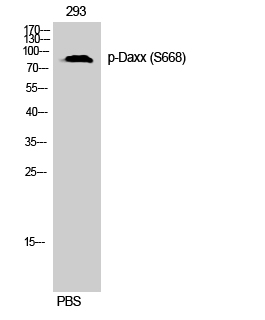
Catalog: KA1244C
Size
Price
Status
Qty.
96well
$470.00
In stock
0
Add to cart


Collected


Collect
Main Information
Reactivity
Human
Applications
ELISA
Conjugate/Modification
Phospho
Detailed Information
Storage
2-8°C/6 months,Ship by ice bag
Modification
Phospho
Detection Method
Colorimetric
Related Products
Antigen&Target Information
Gene Name:
DAXX
show all
Other Name:
Death domain-associated protein 6 ;
Daxx ;
hDaxx ;
ETS1-associated protein 1 ;
EAP1 ;
Fas death domain-associated protein ;
Daxx ;
hDaxx ;
ETS1-associated protein 1 ;
EAP1 ;
Fas death domain-associated protein ;
show all
Background:
function:Proposed to mediate activation of the JNK pathway and apoptosis via MAP3K5 in response to signaling from TNFRSF6 and TGFBR2. Interaction with HSPB1/HSP27 may prevent interaction with TNFRSF6 and MAP3K5 and block DAXX-mediated apoptosis. In contrast, in lymphoid cells JNC activation and TNFRSF6-mediated apoptosis may not involve DAXX. Seems to regulate transcription in PML/POD/ND10 nuclear bodies together with PML and may influence TNFRSF6-dependent apoptosis thereby. Down-regulates basal and activated transcription. Seems to act as a transcriptional co-repressor and inhibits PAX3 and ETS1 through direct protein-protein interaction. Modulates PAX5 activity. Its transcription repressor activity is modulated by recruiting it to subnuclear compartments like the nucleolus or PML/POD/ND10 nuclear bodies through interactions with MCSR1 and PML, respectively.,induction:Upon mitogenic stimulation by concanavalin A.,PTM:Phosphorylated upon DNA damage, probably by ATM or ATR. Phosphorylated by HIPK1 upon glucose deprivation.,PTM:Polyubiquitinated; which is promoted by CUL3 and SPOP and results in proteasomal degradation.,PTM:Sumoylated.,similarity:Belongs to the DAXX family.,subcellular location:Dispersed throughout the nucleoplasm, in PML/POD/ND10 nuclear bodies, and in nucleoli. Colocalizes with a subset of interphase centromeres, but is absent from mitotic centromeres. Detected in cytoplasmic punctate structures. Translocates from the nucleus to the cytoplasm upon glucose deprivation or oxidative stress.,subunit:Homomultimer. Binds to the TNFRSF6 death domain via its C-terminus and to PAX5. Binds to SLC2A4/GLUT4, MAP3K5, TGFBR2, phosphorylated dimeric HSPB1/HSP27, CENPC1, ETS1, sumoylated PML, UBE2I and MCRS1. Is part of a complex containing PAX5 and CREBBP. Interacts with HIPK2 and HIPK3 via its N-terminus. Interacts with HIPK1, which induces translocation from PML/POD/ND10 nuclear bodies to chromatin and enhances association with HDAC1 (By similarity). The non-phosphorylated form binds to PAX3, PAX7, DEK, HDAC1, HDAC2, HDAC3, acetylated histone H4 and histones H2A, H2B, H3 and H4. Interacts with SPOP. Part of a complex consisting of DAXX, CUL3 and SPOP. Interacts with CBP; the interaction is dependent the sumoylation of CBP and suppresses CBP transcriptional activity via recruitment of HDAC2 (By similarity). Interacts with HCMV tegument phosphoprotein pp71.,tissue specificity:Ubiquitous.,
show all
Function:
MAPKKK cascade, activation of MAPK activity, cytokinesis after mitosis, cytokinesis, regulation of protein amino acid phosphorylation, transcription, regulation of transcription, DNA-dependent, protein amino acid phosphorylation,phosphorus metabolic process, phosphate metabolic process, apoptosis, induction of apoptosis, cell cycle, intracellular signaling cascade, protein kinase cascade, JNK cascade, activation of JUN kinase activity, cell death, induction of apoptosis by extracellular signals, negative regulation of biosynthetic process, negative regulation of macromolecule biosynthetic process, negative regulation of macromolecule metabolic process, regulation of protein kinase cascade,negative regulation of gene expression, regulation of cell death, positive regulation of cell death, programmed cell death, induction of programmed cell death, death, phosphorylation, negative regulation of transcription, regulation of phosphate metabolic process, cell cycle process, steroid hormone receptor signaling pathway, androgen receptor signaling pathway, intracellular receptor-mediated signaling pathway, stress-activated protein kinase signaling pathway, negative regulation of cellular biosynthetic process, regulation of protein modification process, regulation of cellular protein metabolic process, cytokinesis during cell cycle, cellular response to stress, positive regulation of kinase activity, regulation of phosphorylation, regulation of apoptosis, positive regulation of apoptosis, regulation of programmed cell death, positive regulation of programmed cell death, positive regulation of catalytic activity,regulation of MAP kinase activity, positive regulation of MAP kinase activity, regulation of MAPKKK cascade, regulation of JUN kinase activity, positive regulation of JUN kinase activity, regulation of kinase activity, positive regulation of molecular function, regulation of transcription, regulation of protein kinase activity, positive regulation of protein kinase activity, negative regulation of transcription, DNA-dependent, negative regulation of nucleobase, nucleoside, nucleotide and nucleic acid metabolic process, regulation of JNK cascade, negative regulation of nitrogen compound metabolic process, regulation of phosphorus metabolic process, regulation of RNA metabolic process, negative regulation of RNA metabolic process, cell division, regulation of transferase activity, positive regulation of transferase activity, regulation of stress-activated protein kinase signaling pathway, regulation of cellular response to stress,
show all
Cellular Localization:
Cytoplasm . Nucleus, nucleoplasm . Nucleus, PML body . Nucleus, nucleolus . Chromosome, centromere . Dispersed throughout the nucleoplasm, in PML/POD/ND10 nuclear bodies, and in nucleoli (Probable). Colocalizes with histone H3.3, ATRX, HIRA and ASF1A at PML-nuclear bodies (PubMed:12953102, PubMed:14990586, PubMed:23222847, PubMed:24200965). Colocalizes with a subset of interphase centromeres, but is absent from mitotic centromeres (PubMed:9645950). Detected in cytoplasmic punctate structures (PubMed:11842083). Translocates from the nucleus to the cytoplasm upon glucose deprivation or oxidative stress (PubMed:12968034). Colocalizes with RASSF1 in the nucleus (PubMed:18566590). Colocalizes with USP7 in nucleoplasma with accumulation in speckled structures (PubMed:16845383). .; [Isoform beta]: Nucleus . Diffuse nuclear distribution pattern and no comparable dot-like accumulation of isoform 1. .; [Isoform gamma]: Nucleus . Diffuse nuclear distribution pattern and no comparable dot-like accumulation of isoform 1. .
show all
Tissue Expression:
show all
Signaling Pathway
Cellular Processes >> Cell growth and death >> Apoptosis
Human Diseases >> Neurodegenerative disease >> Parkinson disease
Human Diseases >> Neurodegenerative disease >> Amyotrophic lateral sclerosis
Human Diseases >> Neurodegenerative disease >> Pathways of neurodegeneration - multiple diseases
Environmental Information Processing >> Signal transduction >> MAPK signaling pathway
Reference Citation({{totalcount}})
Catalog: KA1244C
Size
Price
Status
Qty.
96well
$470.00
In stock
0
Add to cart


Collected


Collect
Recently Viewed Products
Clear allPRODUCTS
CUSTOMIZED
ABOUT US
Toggle night Mode
{{pinfoXq.title || ''}}
Catalog: {{pinfoXq.catalog || ''}}
Filter:
All
{{item.name}}
{{pinfo.title}}
-{{pinfo.catalog}}
Main Information
Target
{{pinfo.target}}
Reactivity
{{pinfo.react}}
Applications
{{pinfo.applicat}}
Conjugate/Modification
{{pinfo.coupling}}/{{pinfo.modific}}
MW (kDa)
{{pinfo.mwcalc}}
Host Species
{{pinfo.hostspec}}
Isotype
{{pinfo.isotype}}
Product {{index}}/{{pcount}}
Prev
Next
{{pvTitle}}
Scroll wheel zooms the picture
{{pvDescr}}

















